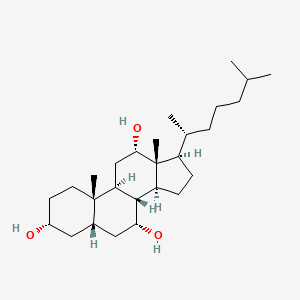| Authors | Title | Published | Journal | PubMed Link |
|---|---|---|---|---|
| Hagey LR et al. | Major biliary bile acids of the medaka (Oryzias latipes): 25R- and 25S-epimers of 3alpha,7alpha,12alpha-trihydroxy-5beta-cholestanoic acid. | 2010 | Zool. Sci. | pmid:20608845 |
| Ung CY et al. | In silico prediction of pregnane X receptor activators by machine learning approaches. | 2007 | Mol. Pharmacol. | pmid:17003167 |
| Persson KP et al. | Evaluation of human liver slices and reporter gene assays as systems for predicting the cytochrome p450 induction potential of drugs in vivo in humans. | 2006 | Pharm. Res. | pmid:16328606 |
| Mast N et al. | Distinct binding of cholesterol and 5beta-cholestane-3alpha,7alpha,12alpha-triol to cytochrome P450 27A1: evidence from modeling and site-directed mutagenesis studies. | 2006 | Biochemistry | pmid:16584175 |
| Krasowski MD et al. | Evolution of the pregnane x receptor: adaptation to cross-species differences in biliary bile salts. | 2005 | Mol. Endocrinol. | pmid:15718292 |
| Dussault I et al. | Identification of an endogenous ligand that activates pregnane X receptor-mediated sterol clearance. | 2003 | Proc. Natl. Acad. Sci. U.S.A. | pmid:12569201 |
| Goodwin B et al. | Identification of bile acid precursors as endogenous ligands for the nuclear xenobiotic pregnane X receptor. | 2003 | Proc. Natl. Acad. Sci. U.S.A. | pmid:12509506 |
| Furster C and Wikvall K | Identification of CYP3A4 as the major enzyme responsible for 25-hydroxylation of 5beta-cholestane-3alpha,7alpha,12alpha-triol in human liver microsomes. | 1999 | Biochim. Biophys. Acta | pmid:9931427 |
| Suzuki Y | [Other peroxisomal diseases]. | 1998 | Ryoikibetsu Shokogun Shirizu | pmid:9645078 |
| Pikuleva IA et al. | Expression, purification, and enzymatic properties of recombinant human cytochrome P450c27 (CYP27). | 1997 | Arch. Biochem. Biophys. | pmid:9210654 |
Trihydroxycoprostane
Trihydroxycoprostane is a lipid of Sterol Lipids (ST) class. The involved functions are known as Uptake, Enterohepatic Circulation, Metabolic Inhibition and Ionization. Trihydroxycoprostane often locates in Hepatic, Entire gastrointestinal tract and Abdominal Cavity. The related lipids are 3,7,12-trihydroxycoprostane, (3beta,5beta,7alpha,12alpha)-isomer, Cholestanes and scymnol.
Cross Reference
Introduction
To understand associated biological information of Trihydroxycoprostane, we collected biological information of abnormalities, associated pathways, cellular/molecular locations, biological functions, related genes/proteins, lipids and common seen animal/experimental models with organized paragraphs from literatures.
What diseases are associated with Trihydroxycoprostane?
There are no associated biomedical information in the current reference collection.
No disease MeSH terms mapped to the current reference collection.
PubChem Associated disorders and diseases
What pathways are associated with Trihydroxycoprostane
There are no associated biomedical information in the current reference collection.
PubChem Biomolecular Interactions and Pathways
Link to PubChem Biomolecular Interactions and PathwaysWhat cellular locations are associated with Trihydroxycoprostane?
Visualization in cellular structure
Associated locations are in red color. Not associated locations are in black.
Related references are published most in these journals:
| Location | Cross reference | Weighted score | Related literatures |
|---|
What functions are associated with Trihydroxycoprostane?
Related references are published most in these journals:
| Function | Cross reference | Weighted score | Related literatures |
|---|
What lipids are associated with Trihydroxycoprostane?
Related references are published most in these journals:
| Lipid concept | Cross reference | Weighted score | Related literatures |
|---|
What genes are associated with Trihydroxycoprostane?
There are no associated biomedical information in the current reference collection.
What common seen animal models are associated with Trihydroxycoprostane?
There are no associated biomedical information in the current reference collection.
